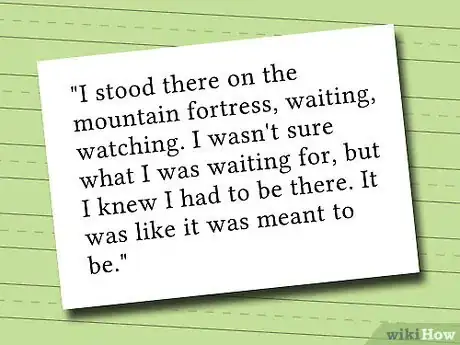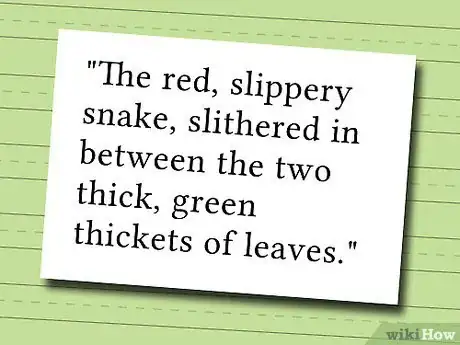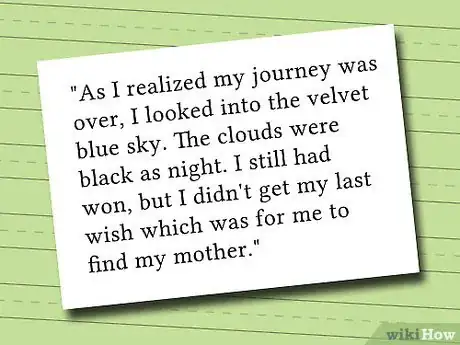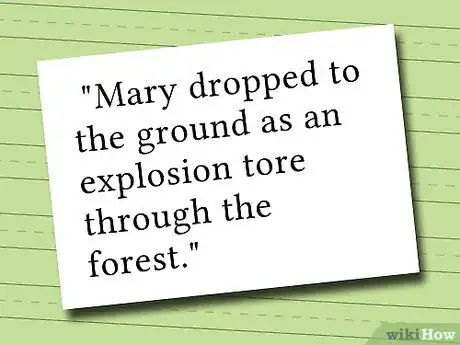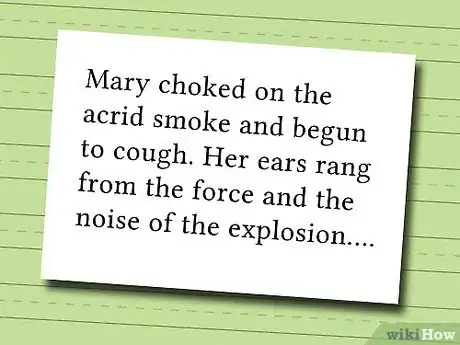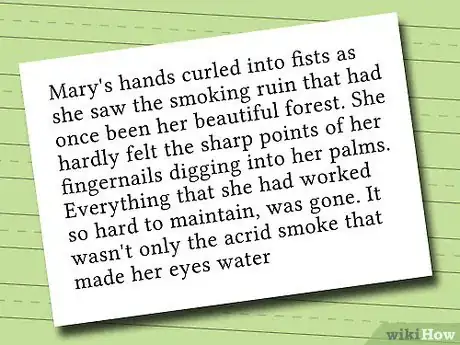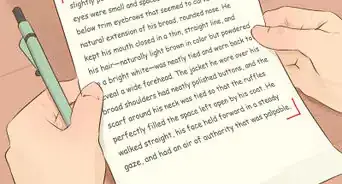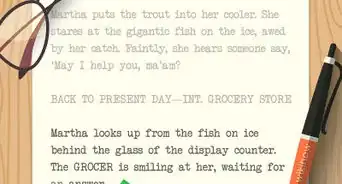wikiHow is a “wiki,” similar to Wikipedia, which means that many of our articles are co-written by multiple authors. To create this article, 37 people, some anonymous, worked to edit and improve it over time.
This article has been viewed 123,657 times.
Learn more...
Writing is a very popular art. In writing, you can express yourself through different passions, feelings, and expressions. Being descriptive is important in writing. How do you make your writing descriptive? See step 1 to get started.
Steps
Getting Started
-
1Be sure to have a great intro. It'll pull the reader into the story and make them want to read on. For example, "I stood there on the great mountain fortress, waiting, watching. I wasn't sure what I was waiting for, but I knew I had to be there. It was like it was meant to be."
-
2Use descriptive language![1] Adjectives are beautiful descriptive words like red, soft, slimy, magnificent, horrid, or scaly. The reader will be able to easily picture what's going on in the story. For example, "The red, slippery snake slithered in between the two thick, green thickets of leaves."Advertisement
-
3Create your conclusion. A catchy ending. Do NOT use "The End". It's boring! Use something great; something that no one has ever used before. For example, "As I realized my journey was over, I looked into the velvet blue sky. The clouds were black as night. I still had won, but I didn't get my last wish which was for me to find my mother."[2]
Using Descriptive Language
-
1Start your story in a way that grabs the reader's attention. Unless you're writing a fairytale, you typically don't want to start by saying "Once upon a time..." Instead, go for something immediately grabs the reader's interest like "Mary dropped to the ground as an explosion tore through the forest." The reader is immediately introduced to the main character and to the main action.
- Don't start with exciting action only to segue immediately into several pages of backstory and exposition. The reader will be irritated that their interest was piqued only to slog through the boring parts.
- For example: if you start your story with Mary and the explosion, continue with that, without going into pages of description of what the forest looked like and what it was doing there and what Mary looked like and Mary's entire history. Instead, get on with what Mary is doing in the forest and what caused the explosion.
-
2Evoke your reader's five senses.[3] Describe what things look like, what they smell like, what sounds can be heard, and what sensations can be felt. This way the reader will feel like they are directly a part of the action and can easily visualize what is happening.
- For example, describe Mary feeling the burning heat of the explosion, have it singe her hair so that she can smell burning hair. Have Mary choke on the acrid smoke and cough. Have Mary's ears ring from the force and the noise of the explosion (and this can be a plot point, for example having Mary get captured, because she couldn't hear her attackers over the ringing in her ears).
- Of course, only describe the things that are important to your story. You can do a little setting of the stage, giving the reader a sense of what the area looks like, but don't overwhelm your reader with every single little detail. Trust your reader to have some imagination.
-
3Describe your character(s)' thoughts and emotions.[4] Allowing the reader insight into your character(s) will make them empathize more with the character and feel more connected to them. Talk about how the events of the story make them feel. How do they change emotionally because of what happens to them and what they make happen because of that?
- For example: Mary might be feeling horrified by the explosion in the forest, because she's dedicated her life to preserving forest habitat, or because one of her friends is near the center of the explosion. Maybe she's devastated because of the explosion, or angry. Or horrified, devastated, and angry.
- Reflect how their thoughts and emotions change over the course of the story. You don't want a static character who does not change at all, neither do you want a character who changes in completely nonsensical ways. For example: Mary might start of the story ashamed that she did not stand up against the people who created the explosion, and over the course of the narrative develop strength and courage that allows her to defeat the bad guys.[5]
-
4Show don't tell.[6] This is the big rule that creative writing teachers and authors across the world bring up. You do not want to spoon-feed your reader your story. You want to use words and language that get across what you're trying to say without having to come right out and say it.
- For example: instead of saying "Mary was angry about the explosion" you could say something like "Mary's hands curled into fists as she saw the smoking ruin that had once been her beautiful forest. She hardly felt the sharp points of her fingernails digging into her palms. Everything that she had worked so hard to maintain, was gone. It wasn't only the acrid smoke that made her eyes water."
Community Q&A
-
QuestionWhat are some suggestions for writing in English if it's not my first language?
 Community AnswerIt could help to have an English speaking friend read through it and show you where it needs improvement.
Community AnswerIt could help to have an English speaking friend read through it and show you where it needs improvement. -
QuestionWhat is the best way to be descriptive in a sad and emotional story?
 Love2009my9Community AnswerDon’t state directly that your character is sad and emotional. Instead of, “Jack was sad,” say something like, “Jack’s eyes filled with tears as his dog ran off the leash into the busy street.”
Love2009my9Community AnswerDon’t state directly that your character is sad and emotional. Instead of, “Jack was sad,” say something like, “Jack’s eyes filled with tears as his dog ran off the leash into the busy street.” -
QuestionIf you're writing a long story, should the level of description go down or stay the same?
 lexicheers 03Community AnswerWell you don't want to bore the readers, so kick it up a notch as you go. In an adventurous scene, say how readers are feeling and their surroundings. Don't be afraid to bring personality to the story.
lexicheers 03Community AnswerWell you don't want to bore the readers, so kick it up a notch as you go. In an adventurous scene, say how readers are feeling and their surroundings. Don't be afraid to bring personality to the story.
References
- ↑ https://www.readingrockets.org/strategies/descriptive_writing
- ↑ https://jerryjenkins.com/how-to-end-a-story/
- ↑ https://io9.gizmodo.com/how-to-write-descriptive-passages-without-boring-the-re-1479764153
- ↑ https://www.livewritethrive.com/2015/06/24/how-fiction-writers-can-show-emotions-in-their-characters-in-effective-ways/
- ↑ https://www.livewritethrive.com/2015/06/24/how-fiction-writers-can-show-emotions-in-their-characters-in-effective-ways/
- ↑ https://www.time4writing.com/writing-resources/descriptive-essay/
About This Article
A good descriptive story can totally transport a reader. To write one, you’ll need to start with an exciting introduction that pulls readers into the story. For example, you might start with a sentence like, “Mary dropped to the ground as an explosion tore through the forest.” Try to use descriptive language throughout the story that evokes your reader’s 5 senses. Besides descriptions of the scene, you’ll also want to describe your character’s thoughts and emotions. For example, you could say “Mary was horrified by the silence she heard following the explosion.” Finally, as you're wrapping up, make sure to include a catchy and unique ending to make your story more memorable. To learn how to show character development, read on!
